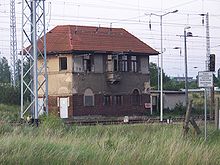- Roßlau–Falkenberg/Elster railway
-
Roßlau (Elbe)–Falkenberg (Elster) Route number: 216 Line length: 85.5 Gauge: 1435 Voltage: 15 kV 16.7 Hz AC Legend
from Dessau 
233.7 Roßlau (Elbe) 70 m 
B 184 



from and to Magdeburg 

231.8 Roßlau (Elbe) freight yard 

Rossel 

231.2 Meinsdorf 

to Belzig 


222.7 Klieken 
A 9 
Private siding 



former siding to Coswig port 

217.6 Coswig (Anh) freight yard 

former match factory siding 




B 187a 
216.7 Coswig (Anh) 84 m 
B 107 
212.1 Griebo 
210.3 Apollensdorf 







PCI Augsburg siding 



SKW GmbH nitrogen works sidings 

SKW nitrogen works freight yard 



SKW northern siding 


208.3 Lutherstadt Wittenberg-Piesteritz 
Melamine works siding 
SKW port siding 
private siding 
206.1 Lutherstadt Wittenberg West 
from Straach 
B 2 
203.7 Lutherstadt Wittenberg-Altstadt 
from Halle (Saale) 
201.9 Lutherstadt Wittenberg 71 m 
to Berlin 



former Labetz depot 


199.2 Lutherstadt Wittenberg-Labetz (Wendel) 
195.1 Mühlanger previously: Prülitz 
former private siding 
189.0 Elster (Elbe) 73 m 
former private siding 
179.1 Jessen (Elster) 75 m 
B 187 
Schwarze Elster 
170.1 Annaburg 76 m 
to Prettin 
Saxony-Anhalt–Brandenburg state border 
156.5 Fermerswalde 82 m 
B 87 
153.7 Beyern 
Link to Jüterbog–Riesa and Uckro lines 
from Jüterbog and Uckro 



148.2 Falkenberg (Elster) from Halle (Saale) 87 m 

to Riesa 

to Cottbus 

to Ruhland The Roßlau–Falkenberg/Elster railway is a double-track, electrified standard gauge railway line in the German state of Saxony-Anhalt. The line begins at Roßlau station in Dessau-Roßlau and runs through Wittenberg to the Brandenburg town of Falkenberg/Elster. The western section of the line is one of the oldest lines in Germany.
Contents
History
Ideas and beginnings
The Berlin-Anhalt Railway Company (German: Berlin-Anhaltische Eisenbahn-Gesellschaft, BAE) was one of the major railway companies in Germany for more than four decades during the 19th century. The company built a major network of rail links between Berlin and the northern part of the Kingdom of Saxony, of Prussian Province of Saxony and the Duchy of Anhalt with a total length of 430 kilometres.
Planning and construction
The Anhalt main line ran from Köthen to Dessau, Wittenberg and Berlin. This line was opened between Dessau and Coswig on 18 August 1841 and between Coswig and Wittenberg on 28 August 1841. On 10 September 1841, the line was extended to Jüterbog (where it met the already completed line to Berlin) and to Köthen.
The construction of new routes by the BAE, along with the growth of competing railway networks, forced constant adjustments to rail services to respond to changing demand. Thus, the southern section of the original line between Wittenberg, Dessau and Köthen became a branch line.
On 15 October 1875, the BAE opened the Wittenberg–Falkenberg section.
Second World War
On 20 April 1945, there was an air raid on Piesteritz station, which blew up several wagons and also caused significant damage to a nitrogen plant. The explosion was so powerful that the wheels and axles of a tank wagon were hurled 500 metres to the present highway 187.[1]
Operations
Passengers
Currently, this route is served by DB Regio Regionalbahn trains running between Dessau and Falkenberg. The trains take around 90 minutes to cover the approximately 91 km long line. Services are provided by push-pull trains consisting of Class 143 locomotives and at least two double-deck coaches, including a double-deck driving coach.
Freight traffic
The line is also important for freight transport. That line carries frequent services to the Piesteritz nitrogen works in Wittenberg, using an extensive network of freight rail facilities. In addition, the line is being developed to play an important role in international freight services to Poland. The line, along with the Węgliniec–Falkenberg/Elster line, will become, once construction work is completed, one of the most important corridors for freight between Eastern and Western Europe.
Stations
- Lutherstadt Wittenberg-Piesteritz station is located within the facilities of the nitrogen factory and had an important role in peak hours during the existence of East Germany because up to 9,000 people were employed in the nitrogen works. At present, this station is of minor importance for the residents of Piesteritz, since Wittenberg West station is better located. However, it still has significant traffic for students attending the Berufsbildungszentrum Elbe training school.
- The Falkenberg (Elster) station is on two intersecting levels. On the top level is the platform for the DB Regio Regional-Express hourly service between Hoyerswerda or Cottbus and Leipzig. On the lower level is the platform for trains on the Dessau-Falkenberg line. Regional-Express Line 5 services supported by the VBB on the Stralsund–Berlin–Falkenberg route, operated by DB Regio on the Jüterbog–Riesa line, terminate in Falkenberg. Until 2004, Regionalbahn trains continued to Riesa.
- The old Wittenberg Station of 1841 is one of the oldest station buildings in Germany and was originally located in the Anhalt trunk line, between the present Wittenberg-West and Wittenberg-Altstadt stations.
Sources
Notes
- ^ "Deutsches Chemie-Museum Merseburg: Wittenberg/Piesteritz". http://www.dchm.de/index.php?id=34. Retrieved 3 August 2010.
References
- Track data from Eisenbahnatlas Deutschland (German railway atlas). Schweers + Wall. 2007. ISBN 978-3-89494-136-9.
Categories:- Railway lines in Saxony-Anhalt
- Railway lines in Brandenburg
Wikimedia Foundation. 2010.

